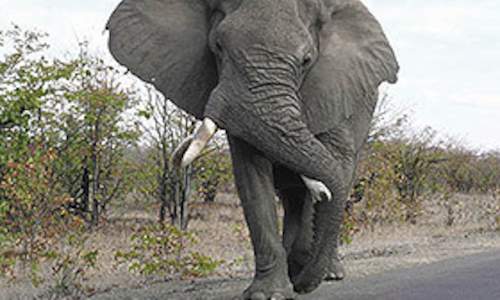
MaMerle, believed to the biggest female tusker in the Kruger National Park (KNP), seems determined to be recorded in the Guinness book of elephant records. She was sighted recently with twin calves for the second time in the past five years. According to Dr Ian Whyte, an expert on Kruger’s elephants, this is very rarely seen.
MaMerle was first seen and photographed near the Sabie River high-water bridge on August 14, 2004. She was also photographed during the 2004 elephant census from the helicopter. She appeared to have had twins of about three to four years old then as they were with her on both occasions.
What was also uncommon was that both seemed to have survived. More often than not one of a pair of elephant twins does not survive as the mother can usually not supply enough milk for two rapidly growing young elephants. And now she has had another set of twins!
The most recent set of photos, taken by section ranger Steven Whitfield in the Rhino Walking Safaris concession area near Tshokwane, shows the new calves to be about one year old. “It is definitely MaMerle. She has very distinctive notches in her left ear,” says Ian. Unfortunately she has broken the tips off both of her tusks, and is not the “tusker” she once was.

This ensures that the mother has plenty to eat while she is suckling her calf. “Females between 14 to 45 years may give birth to calves approximately every four years with the mean interbirth intervals increasing to five years by age 52 and six years by age 60. “Interbirth intervals of up to 13 years may occur depending upon habitat conditions and population densities.The mean calving interval varies from population to population, with high density populations or otherwise nutritionally stressed populations exhibiting longer intervals between births. “After 22 months growing inside its mother's womb, a newborn baby elephant weighs more than the average adult human being. Female calves weigh 90 to100 kg.
Males are heavier and weigh up to 120 kg.” MaMerle is named after one of the other matriarchs of Kruger, Merle Whyte, who also has an extended family living in Kruger and the neighbouring associated private nature reserves. Merle and her husband, Dr Ian Whyte, lived in the Park for many years. They both recently retired and settled in Graskop.

 Six elephants have been added to the Kruger National Park's (KNP) list of upcoming tuskers, courtesy of the enthusiastic participation of vi...
Six elephants have been added to the Kruger National Park's (KNP) list of upcoming tuskers, courtesy of the enthusiastic participation of vi...